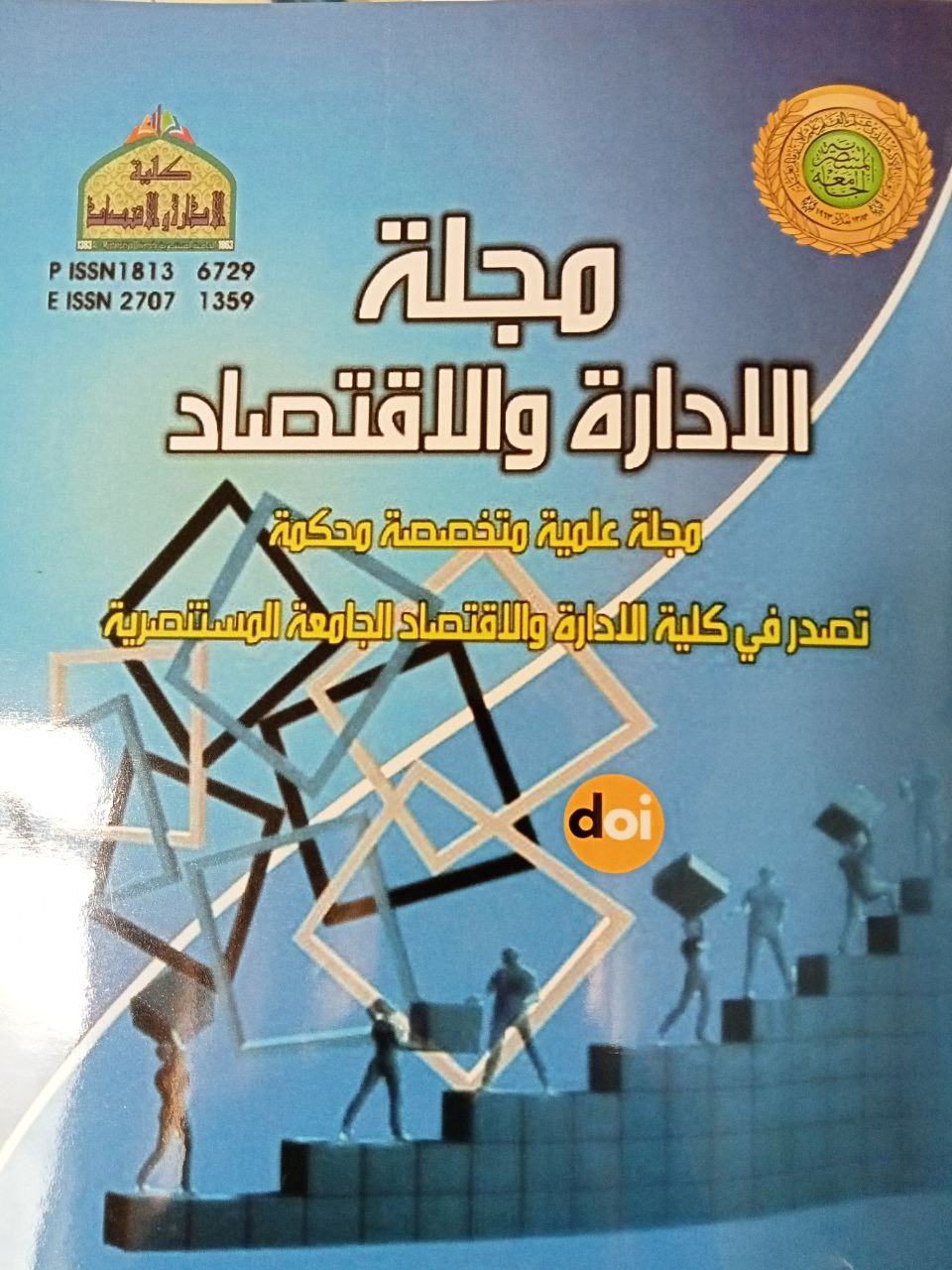The effect of a sustainable balanced scorecard for strategic decision-making under uncertain competitive and climate conditions evidence from Iraq
DOI:
https://doi.org/10.31272/jae.i128.83Keywords:
making decision, peripheral policy, assessment, sustainability system dynamicsAbstract
The present study attempts to use a complex sustainability balanced scorecard to provide a new paradigm in order to make strategic decisions in a tumultuous world (BSC). The fuzzy TOPSIS approach is used to pick environmental variables, which are then applied to a complex BSC model for an organization. The model of making decision is divided into three major scripts: "optimistic" (economical development script), "realistic" (normal long-term economic condition), and "pessimistic" (maintenance of existing penalty situation script), as well as two nterior politics: generation increase and productivity maximization. For the hierarchical BSC model, the model is independently simulated in each situation and strategy, and every significant feature of the organization is studied, for the bulk of income and long-term viability. The findings suggest that in each case, a particular strategy is favored, which may aid strategic managers in making decisions in volatile and chaotic situations. Due to the growing sophistication of companies in today's competitive world, performance assessment frameworks must be proposed. One of the most commonly used approaches for measuring project efficiency that can be adapted to particular situations is the "Balanced Scorecard (BSC)" approach.
Downloads
References
[1] E. Trisyulianti, K. Suryadi, and B. Prihantoro, “A Conceptual Framework of Sustainability Balanced Scocecard for State-Owned Plantation Enterprises,” in 2020 7th International Conference on Frontiers of Industrial Engineering (ICFIE), 2020, pp. 62–66.
[2] A. Rabbani, M. Zamani, A. Yazdani-Chamzini, and E. K. Zavadskas, “Proposing a new integrated model based on sustainability balanced scorecard (SBSC) and MCDM approaches by using linguistic variables for the performance evaluation of oil producing companies,” Expert Syst. Appl., vol. 41, no. 16, pp. 7316–7327, 2014.
[3] H. Zhao and N. Li, “Evaluating the performance of thermal power enterprises using sustainability balanced scorecard, fuzzy Delphic and hybrid multi-criteria decision making approaches for sustainability,” J. Clean. Prod., vol. 108, pp. 569–582, 2015.
[4] S. Agrawal, R. K. Singh, and Q. Murtaza, “Outsourcing decisions in reverse logistics: Sustainable balanced scorecard and graph theoretic approach,” Resour. Conserv. Recycl., vol. 108, pp. 41–53, 2016.
[5] J.-S. Kang, C.-F. Chiang, K. Huangthanapan, and S. Downing, “Corporate social responsibility and sustainability balanced scorecard: The case study of family-owned hotels,” Int. J. Hosp. Manag., vol. 48, pp. 124–134, 2015.
[6] M.-T. Lu, C.-C. Hsu, J. J. H. Liou, and H.-W. Lo, “A hybrid MCDM and sustainability-balanced scorecard model to establish sustainable performance evaluation for international airports,” J. Air Transp. Manag., vol. 71, pp. 9–19, 2018.
[7] F. Figge, T. Hahn, S. Schaltegger, and M. Wagner, “The sustainability balanced scorecard–linking sustainability management to business strategy,” Bus. Strateg. Environ., vol. 11, no. 5, pp. 269–284, 2002.
[8] C. A. L. Vanegas, G. A. Cordeiro, C. P. de Paula, R. E. C. Ordoñez, and R. Anholon, “Analysis of the utilization of tools and sustainability approaches in the product development process in Brazilian industry,” Sustain. Prod. Consum., vol. 16, pp. 249–262, 2018.
[9] I. E. Nikolaou and T. A. Tsalis, “Development of a sustainable balanced scorecard framework,” Ecol. Indic., vol. 34, pp. 76–86, 2013.
[10] A. N. Junior, M. C. de Oliveira, and A. L. Helleno, “Sustainability evaluation model for manufacturing systems based on the correlation between triple bottom line dimensions and balanced scorecard perspectives,” J. Clean. Prod., vol. 190, pp. 84–93, 2018.
[11] C. S. Pedamallu, L. Ozdamar, H. Akar, G.-W. Weber, and A. Özsoy, “Investigating academic performance of migrant students: A system dynamics perspective with an application to Turkey,” Int. J. Prod. Econ., vol. 139, no. 2, pp. 422–430, 2012.
[12] O. Tang and J. Rehme, “An investigation of renewable certificates policy in Swedish electricity industry using an integrated system dynamics model,” Int. J. Prod. Econ., vol. 194, pp. 200–213, 2017.
[13] G. Ozcan-Deniz and Y. Zhu, “A system dynamics model for construction method selection with sustainability considerations,” J. Clean. Prod., vol. 121, pp. 33–44, 2016.
[14] J. Sterman, “System Dynamics: systems thinking and modeling for a complex world,” 2002.
[15] D. C. de Salles, A. C. G. Neto, and L. G. Marujo, “Using fuzzy logic to implement decision policies in system dynamics models,” Expert Syst. Appl., vol. 55, pp. 172–183, 2016.
[16] S. Ahmad, R. M. Tahar, F. Muhammad-Sukki, A. B. Munir, and R. A. Rahim, “Application of system dynamics approach in electricity sector modelling: A review,” Renew. Sustain. Energy Rev., vol. 56, pp. 29–37, 2016.
[17] I. Nikolaou, K. Evangelinos, and W. Leal Filho, “A system dynamic approach for exploring the effects of climate change risks on firms’ economic performance,” J. Clean. Prod., vol. 103, pp. 499–506, 2015.
[18] R. Poles, “System Dynamics modelling of a production and inventory system for remanufacturing to evaluate system improvement strategies,” Int. J. Prod. Econ., vol. 144, no. 1, pp. 189–199, 2013.
[19] T. Zhang and L. Gao, “Study on the Application of Dynamic Balanced Scorecard in the Service Industry,” in 2008 International Conference on Intelligent Computation Technology and Automation (ICICTA), 2008, vol. 1, pp. 1158–1162.
[20] R. Espejo, S. B. Khakbaz, and N. Hajiheydari, “Proposing a basic methodology for developing balanced scorecard by system dynamics approach,” Kybernetes, 2015.
[21] Z. Hoque, F. Barnabè, and C. Busco, “The causal relationships between performance drivers and outcomes,” J. Account. Organ. Chang., 2012.
[22] M. Zandieh, S. Y. Shariat, M. Rabieh, and M. Tootooni, “A new framework for dynamic sustainability balanced scorecard in order to strategic decision making in a turbulent environment,” J. Ind. Syst. Eng., vol. 12, no. 4, pp. 107–135, 2020.
[23] S. Nielsen and E. H. Nielsen, “System dynamics modelling for a balanced scorecard,” Manag. Res. News, 2008.
[24] F. Barnabè, “A ‘system dynamics‐based Balanced Scorecard’ to support strategic decision making,” Int. J. Product. Perform. Manag., 2011.
[25] E. Supino, F. Barnabè, M. C. Giorgino, and C. Busco, “Strategic scenario analysis combining dynamic balanced scorecards and statistics,” Int. J. Product. Perform. Manag., 2019.
[26] S. Koul, O. A. Falebita, J.-F. K. Akinbami, and J. B. Akarakiri, “System dynamics, uncertainty and hydrocarbon resources modelling: A systematic review,” Renew. Sustain. Energy Rev., vol. 59, pp. 199–205, 2016.
[27] W. E. Walker et al., “Defining uncertainty: a conceptual basis for uncertainty management in model-based decision support,” Integr. Assess., vol. 4, no. 1, pp. 5–17, 2003.
[28] R. Vecchiato, “Environmental uncertainty, foresight and strategic decision making: An integrated study,” Technol. Forecast. Soc. Change, vol. 79, no. 3, pp. 436–447, 2012.
[29] Y. Barlas, “Formal aspects of model validity and validation in system dynamics,” Syst. Dyn. Rev. J. Syst. Dyn. Soc., vol. 12, no. 3, pp. 183–210, 1996.

Downloads
Published
Issue
Section
Categories
License
Copyright (c) 2021 Journal of Administration and Economics

This work is licensed under a Creative Commons Attribution 4.0 International License.
The journal of Administration & Economics is an open- access journal that all contents are free of charge. Articles of this journal are licensed under the terms of the Creative Commons Attribution International Public License CC-BY 4.0 (https://creativecommons.org/licenses/by/4.0/legalcode) that licensees are unrestrictly allowedto search, download, share, distribute, print, or link to the full text of the articles, crawl them for indexing and reproduce any medium of the articles provided that they give the author(s) proper credits (citation). The journal allows the author(s) to retain the copyright of their published article.
Creative Commons-Attribution (BY)









